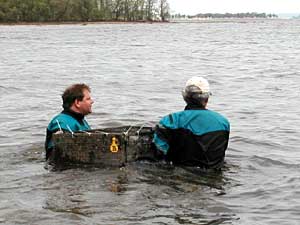| The Grand Excursion |
|
Audio
Photos
Your Voice
|
The decline and fall of the Mississippi
July 1, 2004
 |
| Researchers from the DNR walk a cage containing fish implanted with tiny mussel larvae into Lake Pepin. It's part of a plan to regenerate the Mississippi's mussel population. Virtually all of the mussels were killed by pollution in the mid-1900s. (MPR Photo/Erin Galbally) |
Lake City, Minn. — When the members of the Grand Excursion sailed along the Upper Mississippi River in the early summer of 1854, they witnessed a river on the verge of change. It was defined by a series of tight and braided channels. There were wooded islands and areas so shallow that buffalo herds could cross from one side to the other. Early explorers report parts of the river were crystal clear, while others spots were died red and chocolate brown from the tannins of decaying leaves.
John Anfinson, who has written extensively about the history of the Mississippi River, says by most accounts, the Mississippi River of the 1850's was pristine.
"Steven Long, an explorer in 1817, says the Mississippi name, 'Mississippi' means clear water. It doesn't of course," Anfinson says. "He thought the river was so clear you basically take a glass out and drink it. That's pretty much true of the Mississippi up until 1854."
 | |||
Anfinson says after that point the river's quality quickly eroded and it wasn't long before the growth of the Twin Cities transformed the river into little more than a trash receptacle. It became clogged with human waste, saw dust from lumber yards, thousands of animal carcasses from meat packing plants in South St Paul and other debris.
In 1917, the Army Corps of Engineers constructed Lock and Dam 1 between Minneapolis and St Paul. Anfinson says a few years later the sludge bordering the lock was 12 feet deep.
"The organic sewage and other material in the summer would heat up and gas bubbles would boil to the surface, mats of sewage would start floating to the surface, and the stench from the river was almost unbearable," says Anfinson.
Unsurprisingly this spelled disaster for the river's ecosystem. Biologists predicted an end to fish and other life on the river. Preservation was considered hopeless.
It's taken decades, but now there's reason to believe that some of the river's animal and plant life is on the rebound.
At one point mussel experts feared the river's entire population was on the verge of extinction. They urged collectors to gather up any remaining species. That's no longer the case. For the past few years scientists have been gradually reintroducing the endangered Higgins Eye Pearly Mussel to its native home.
 | |||
The reintroduction process works this way -- small fish are implanted with mussel larvae the size of a grain of salt. The fish are placed in homemade chicken wire cages and then the cages are relocated into the deep water of Lake Pepin. Eventually the mussel larvae will drop off the fish and begin to grow.
Earlier this spring, Mike Davis of the Minnesota DNRT dons a dry suit, and stands in water up to his waist. He says there were times in the not too distant past where oxygen levels on the river were zero. Davis says the mussel project is proof that oxygen levels have improved and that means so has water quality.
"It's interesting because this is on of the few places in the country where we have a re-colonizing in a river," says Davis. "Most places are going the opposite direction but because we have oxygen, the fish are coming back and with them the mussels have been coming back."
There's still plenty of work to do.
For example, the population of species native to river like paddle fish and sturgeon remain low. Until islands and flood plains are rebuilt they likely won't rebound. But Davis says overall it's amazing just how well the river has recovered.
"So we're kind of intervening on behalf of the mussels, to try to put these cogs in the ecosystem back together piece by piece," he explains.
 | |||
The mussel is not the only success story to report. Bald eagles can now be easily spotted soaring along the bluffs that line the Upper Mississippi. Their numbers have steadily flourished, and there are plans to remove the bird from the endangered species list.
Fred Lesher has watched bird life along the Mississippi since he was a boy around World War II. Recently, he stood on the edge of a flooded boat landing, beneath a canopy of trees, and listens.
"I'm hearing a catbird, a red-eyed vireo, and a song sparrow. A peewee, which is a flycatcher. I don't actually hear any prothonotary warblers - actually they were just seen here a few weeks ago," says Lesher.
Besides these smaller birds, come fall huge swaths of the river will be covered with thousands of tundra swans, and rows of canvasback ducks will stretch for miles.
But the news is not all good.
Dan Engstrom, a geologist who runs the Science Museum's St. Croix Watershed Research Station, has the evidence. Engstrom was commissioned to study the history of Lake Pepin a few years ago. Working with a team of scientists, he began by taking a series of deep sediment samples from this wide spot in the river. Each contained details about the lake dating back some 200 years.
 | |||
Engstrom says the results were startling. Lake Pepin is threatened by run off. The source of the threat isn't from sewage or anything like that. Instead it comes from one of the Mississippi's tributaries - the Minnesota River. A huge amount of farm runoff is settling in the bottom of Lake Pepin.
Dan Engstrom says it's the equivalent of a large dump truck filled with powdered rock passing through the river at St. Paul every ten minutes.
"Volume-wise, that's about a cubic city block. You know a block high, by a block wide, by a block long," Engstrom says. "We are filling the lake a rate 10 times faster than in the past. This means we've shortened the lifespan."
The sediment is smothering and killing the lake. That means the newly reintroduced Higgins Eye Pearly mussel, along with fish and plant life. Everything that depends on Lake Pepin for survival. Even the eagles will likely go elsewhere.
Engstrom predicts that if sediment continues at that rate, Lake Pepin will disappear entirely in about three hundred years. Parts of it will vanish long before that.
Since the sediment comes from thousands of sources, stopping its flow is challenging. But Engstrom says if nothing is done, the next time the Grand Excursion's commemorated we may not have as much to celebrate as we do this time.
|
News Headlines
|
Related Subjects
|

